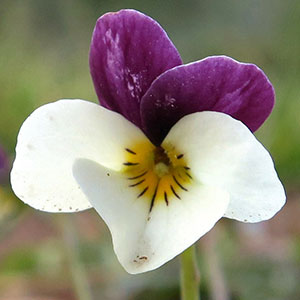Viola hallii
Viola sempervirens
Hall's violet, Oregon violet, wild pansy
evergreen violet, redwood violet, redwoods violet, trailing yellow violet, violette toujours verte
1–3, decumbent or ascending to erect, ca. 1/2 subterranean, glabrous, clustered on single, short, vertical, deep-seated caudex.
1–5, prostrate, spreading, glabrous or sparsely puberulent, from current and/or previous year’s growth, on usually vertical, fleshy rhizome, rooting and forming rosettes at or near tip; rooted rosettes often develop into an erect, fleshy caudex from which new stems are produced.
basal and cauline;
basal: 1–4, palmately compound, ± 2-ternate or 3-ternate, leaflets 3;
stipules adnate to petiole, forming 2 linear-lanceolate wings, unlobed, margins entire, apex of each wing free, acute;
petiole 5–8 cm, glabrous;
blade ovate to deltate, 2.8–6 × 2.6–6.5 cm, ± coriaceous, base tapered, ultimate lobes narrowly elliptic, lanceolate, or oblanceolate, 1–7 mm wide, margins entire, ciliate or eciliate, apex acute, mucronulate, surfaces glabrous;
cauline similar to basal except: stipules usually lanceolate, sometimes broadly ovate, ± leaflike, margins toothed;
petiole 1.3–6 cm;
blade 2–4.8 × 1.2–5.5 cm.
evergreen, basal and cauline;
basal: 1–6(–10);
stipules deltate to ovate or linear-lanceolate, margins entire or glandular-toothed, apex acute to long-acuminate;
petiole 2–16 cm, glabrous;
blade often purple-spotted abaxially and/or adaxially, orbiculate to ovate, 1–4.5 × 2–3.9 cm, base cordate to truncate, margins crenate, eciliate, apex blunt to obtuse, mucronulate, surfaces glabrous or with scattered bristles on one or both surfaces;
cauline similar to basal except: stipules deltate to lanceolate, margins entire or sparingly toothed;
petiole 0.3–3 cm;
blade 1.2–2.2 × 1.2–2 cm.
2.5–11 cm, glabrous.
5–10 cm, glabrous.
sepals lanceolate to ovate, margins ciliate, auricles 0.5–1 mm;
petals: upper 2 almost black abaxially, dark reddish violet adaxially, lower 3 pale yellow, cream, or ± white, lateral 2 bearded, with deep yellow to orange patch basally, dark reddish violet-veined, lowest with deep yellow to orange patch basally, dark reddish violet-veined, 5–18 mm, spur yellow, gibbous, 0.5–2 mm;
style head bearded; cleistogamous flowers absent.
sepals lanceolate to ovate-lanceolate, margins eciliate, auricles 1–2 mm;
petals lemon-yellow on both surfaces, lower 3 and sometimes upper 2 brownish purple-veined, lateral 2 bearded, lowest 8–17 mm, spur yellow or whitish, gibbous, 1–2.5 mm;
style head bearded; cleistogamous flowers axillary.
ellipsoid, 4–12 mm, glabrous.
mottled with purple, spherical to ovoid, 5–8 mm, glabrous.
light brown, shiny, 3.2–3.5 mm.
brown, tinged purple, 2–2.5 mm.
= 60, 72.
= 24, 48.
Viola hallii
Viola sempervirens
Viola hallii was discovered on the grounds of Willamette University in Salem, Oregon, by Elihu Hall, a professor at that institution (V. B. Baird 1942). Leaves of V. hallii are similar to V. beckwithii.
(Discussion copyrighted by Flora of North America; reprinted with permission.)
In California, Viola sempervirens occurs in shaded redwood forests and other coastal forest habitats. In Oregon and Washington, it occurs in Douglas fir and other coniferous forests, where it can form mats (clones) one meter or more in diameter; its prostrate, spreading growth habit is similar to V. walteri. The leafy stems of V. sempervirens are similar to the leafy stolons of V. odorata.
(Discussion copyrighted by Flora of North America; reprinted with permission.)
- Local floras:
BC,
CA,
OR,
WA
- Local Web sites:
CalFlora,
CalPhotos,
Flora NW,
PNW Herbaria,
Turner Photog.
WildflowerSearch
iNaturalist (observations)
USDA Plants Database
- LBJ Wildflower Center
- SEINet
- Plants of the World Online
- Encyclopedia of Life
- Wikipedia
- Google Image Search


